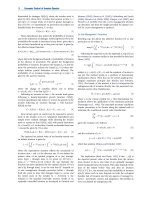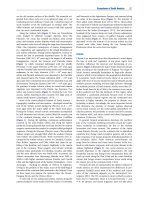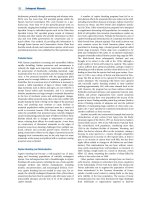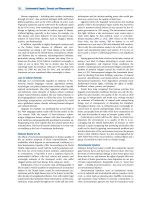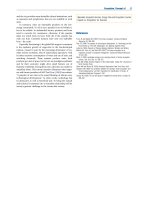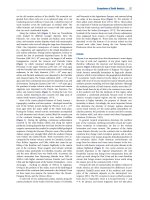Encyclopedia of biodiversity encyclopedia of biodiversity, (7 volume set) ( PDFDrive ) 1779
Bạn đang xem bản rút gọn của tài liệu. Xem và tải ngay bản đầy đủ của tài liệu tại đây (45.73 KB, 1 trang )
196
Endangered Mammals
biodiversity, primarily through monitoring and advisory roles.
IUCN now has more than 100 specialist groups within the
Species Survival Commission SSC, each focused on a particular taxa. More than 30 of the specialist groups work on
mammals, ranging from multiple orders such as the Afrotheria
Specialist Group to individual species such as the Polar Bear
Specialist Group. SSC specialist groups consist of volunteer
scientists and other experts who provide information on their
taxa and even lobby governments for conservation and research efforts. One method of providing this information is
through Status Surveys and Conservation Action Plans that
describe trends, threats, and conservation options, which most
specialist groups have now published for their particular taxa.
Protected Areas
With human population increasing and unmodified habitat
rapidly dwindling, habitat protection and maintenance is
certainly the single most important conservation method for
the preservation of biodiversity, including mammals. Large
mammals often live at low densities and over large individual
areas. A few protected meadows with the appropriate plant
species may be enough habitat to maintain a population of
butterflies, but an enormous tract of wilderness is necessary to
sustain a viable population of tigers or rhinos. Sadly, many
large mammals, such as rhinos and tigers, are now entirely or
mostly found within park boundaries, and it is uncertain
whether populations are large enough to maintain themselves
in the face of stochastic events and anthropogenic changes.
Mammals within protected areas often come into conflict with
people sharing the land or living on the edges of the protected
areas, and poaching may continue to cause declines in
mammal populations within protected areas for a variety of
social or economic reasons. With climate change, there also
exists the possibility that protected areas currently designed
around maintaining particular types of habitat will have those
habitats altered due to changes in temperature or precipitation, reducing their efficacy for certain species. A new focus
on conservation of threatened mammals on the edges of
protected areas faces daunting challenges from multiple use,
social, cultural, and economic growth issues. However, targeting conservation efforts on the edges of protected areas by
engaging local communities may be the only hope for some
mammals, as the money and political will to continue creating
protected areas is limited.
Captive Breeding and Reintroduction
Captive breeding has become a well-accepted way of managing and increasing populations of critically endangered
species. New techniques have led to breakthroughs in captive
breeding with some species, including the use of extra-specific
surrogate mothers and embryo manipulation, including
transfer, cryo-preservation, and microsurgical division. However, captive breeding has not worked in every case. For example, the critically endangered Sumatran rhino (Dicerorhinus
sumatrensis) has been bred in captivity only after many years of
unsuccessful attempts, and the loss of 32 of the original 40
captive animals.
A number of captive breeding programs have led to reintroduction efforts for mammals that were extinct in the wild,
including wisent (Bison bonasus) in Europe, Arabian oryx (Oryx
leucoryx) in Oman, and Pe´re David’s deer (Elaphurus davidianus) in China. Other reintroduction programs have attempted
to supplement decreasing wild populations; for example, one
third of wild golden lion tamarins (Leontopiihecus rosalia) are
now from captive-bred stock. Perhaps the best-known case of
captive breeding and reintroduction of a mammal involves the
black-footed ferret (Mustela nigripes). This small carnivore was
once common across the North American plains, where it
specialized in hunting large, colonial ground squirrels called
prairie dogs (Cynomys). Prairie dogs were considered to be
pests and competitors with cattle, so an intensive eradication
program eventually reduced historic prairie dog range by 98%.
The black-footed ferret subsequently declined and was
thought to be extinct in the wild in the 1970s, although a
small number of ferrets still existed in captivity. This captive
colony suffered from physical problems, perhaps related to
inbreeding as well as disease, and the colony died out in 1979,
leading to fears that the species had truly gone extinct. However, in 1981 a new colony of ferrets was discovered in Wyoming. The first six ferrets to be captured for breeding died of
canine distemper. The remaining wild ferrets were captured
and successful captive breeding resulted in their numbers
reaching approximately 300, with some released back to the
wild. However, the program has not been without criticism:
Politically motivated decisions and arguments between state,
federal, and private organizations have caused numerous
problems and may have even jeopardized the success of the
project at times. Finding suitable prairie dog colonies (both in
terms of finding colonies of adequate size and the political
difficulty of maintaining large numbers of what many consider to be a ‘‘pest’’ species) for continued reintroduction is yet
another roadblock to ferret recovery.
Another successful and controversial example has been the
reintroduction of gray wolves (Canis lupus) into the Rocky
Mountain region of the USA in 1995 on Forest Service lands in
Central Idaho and in 1996 in the Yellowstone National Park.
The reintroduced wolf population, numbering more than
1500 in the Northern Rockies of Montana, Wyoming, and
Idaho, has had an obvious effect on the ecosystem, causing a
decrease in some species (i.e., coyotes, through competition
and killing) and an increase in other species (due, at least in
part, to an increase in carrion from wolf kills, but also from
ripple effects related to changes in elk habitat use and distribution). This reintroduction has not been without controversy, partly stemming from wolf predation on livestock. In
2009, during a single attack on a ranch in Montana, wolves
killed 122 sheep, surpassing the number of sheep killed by
wolves in the entire state in 2008.
Other predator reintroduction attempts have not fared so
well, however. Attempts to reintroduce lynx (Lynx canadensis)
in the Adirondacks of New York have failed. The decision by
French authorities not to augment the population of brown
bears reintroduced in the Pyrenees Mountains of France
amidst a hostile social context is casting doubt on the longterm viability of the bear population. The success of many
reintroductions has also been threatened by legal challenges
from individuals or organizations opposed to land-use
